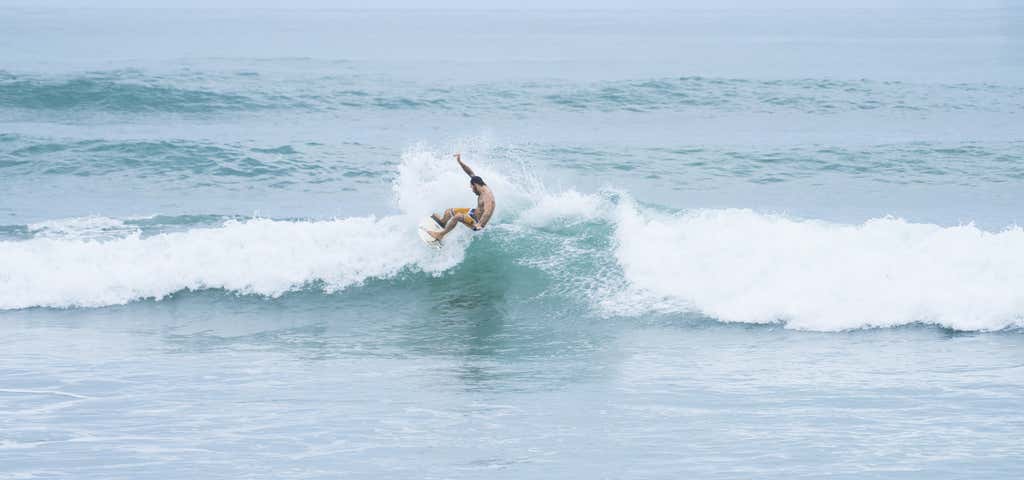Heart-shaped and located 240km south of mainland Australia across the Bass Strait is the world’s 26th largest island. Majority of Tasmania is remote wilderness preserved in national parks and reserves. Its 4,882km of coastline sits right on the 42nd parallel south and in the firing zone of the big southern storm generators. Tasmania’s west, south and eastern edges are where the best waves make landfall with line-ups ranging from outright scary, like Shipstern’s Bluff, to some playful long points and beach breaks. This far south, you’ll need a decent steamer with water temperatures oscillating between 10°C and 16°C. Expect empty line-ups and turn that surf discovery dial all the way up as you’ll be walking a long way to some of these breaks. The cold-water coastline of the south west is without doubt the next phase of surf exploration.
Martha Lavinia
Ranked by Tracks magazine as Australia’s best beach break, Martha Lavinia is named after a ship that went down here in 1852. The small island measures around 65km long by 30km wide and is the largest in the Hunter Group. It hovers halfway between the mainland and the western lobe of Tasmania’s love heart – smack, bang in the middle of the Bass Strait. Southern Ocean swells wrap around the northern tip of the island and shape into perfect A-frames as they head back into the same wind that generated them, air-brushing them into perfect, heavy, fast and super-hollow barrels. Worthy of their place in the world’s top 10? Surfing Life Magazine and Kelly Slater think so. And the beauty of an island in the path of the most swell-congested stretch on water? Somewhere is always offshore.
Bay of Fires
The Bay of Fires is a stretch of coast that reaches from Eddystone Point in the north to Binalong Bay in the south and was named after Captain Tobias Furneaux sailed past and observed fires along the beaches belonging to the aboriginals who lived here. The beach picks up any east swell, but comes to life in the big southeast and east groundies. The best peaks form in the south end and near the estuary mouth. This coast is relatively protected, but is offshore in the prevailing southwest winds during winter. There are a few hidden gems in this area (check around St Helens Point) if you manage to go there in a decent swell. Search, explore and you’ll most definitely score.
Redbill Beach
Located on the cusp of the wave-rich Surf Coast, which runs from Bicheno to St Helens Point on the east coast, Redbill Beach is an exposed beach break that cops the big southerly swells, but shines in a chunky east swell. It breaks best at low-tide and can get busy when it’s on. Winter is the most consistent time of year for this Redbill’s and this coast. Be sure to check out the Bicheno Blowhole in between sessions and remember it is the explorer who gets the worm …
Friendly Beaches
Located on the northern end of the Freycinet Peninsula, Friendly Beaches is an exposed beach that is offshore in a southwest wind. It’s a long beach with sand banks and scattered reef picking up any decent-sized south to north swell. You’ll need a 4WD to access the beach, but you’ll find a peak all to yourself. The Freycinet Peninsula is also home to the world-famous Wineglass Bay – well worth a visit, but go early or late to avoid the tourist crush through summer.
Eaglehawk Neck
Within easy striking range, just a one hour drive east of Hobart, Eaglehawk Neck is a beach break in the northern end of Pirates Bay that produces high-quality peaks in a beautiful setting. The neck is a narrow strip of sand that connects the Forestier Peninsula with the Tasman Peninsula. Mostly uncrowded, you can usually find a peak with just a handful on it here. Egg Beach in the middle can also hold a fun wave. Unlike most of Tasmania’s best surf spots access is very simple with lots of carparks to choose from along the beach. If you’re still looking for that heart-in-your-mouth peak, then try the Eaglehawk Reef, a left to the north. Beyond that you’ll find the right-hander at Tessos if the swell is packing enough punch. If the swell is flat check out all the strange rock formations in this area instead.
Cloudy Bay
Bruny Island is a 20-minute ferry ride from Hobart and its southern tip cradles one of Australia’s most beautiful beaches: Cloudy Bay. Facing directly southeast the beach picks up swell year-round and has sand over rock to ensure consistently good banks that can handle the bigger southern swell energy. Score a little bit of north in the wind and this place comes to life. You’ll soon discover why some consider this Tasmania’s best beach break. If the swell is too big on the beach, then explore the west corner of the bay where you will find the long right-hander called Lagoons.
Shipstern Bluff
Shipsterns needs little introduction. It’s that mutant wave that bucks and buckles as it doubles in size and jolts you out of your nightmares. It will leave you in a cold sweat with heart racing – and that’s just dreaming about surfing it. It’s the wave you’d least like to surf and that’s the best idea for any survivalists reading this. But as powerful and frightening as this wave is, it is also intricately beautiful. Located out on Cape Raoul, Shippies comes into view after a 30-minute walk through Tasman National Park. That will take you to the lookout on the cliffs overlooking the wave and that will be as close as you want to get to the place known as Devil’s Point by fisherman. The only way to surf big Shippies is to be whipped in by a savvy jet-ski driver. Then you’ll need to find a line through an impossible slalom course of steps and ledges that only a few have mastered. When it’s smaller – up to triple overhead, it is possible to paddle in, but don’t expect to feel comfortable on take-off. In many ways, Shippies moved the goalposts for slab hunters globally.
Mays Point
May’s Point is a right-hand point break that is as fickle as an honest politician. May’s has three distinct sections and is located just 20-minutes east of Hobart between Cremorne and Lauderdale. For 350 days of the year you’d be forgiven for questioning its place in this list. But when the stars align and the swell fetch tracks directly south into Storm Bay’s narrow window, then the six points along this 5km stretch of coast turn into one of the greatest spectacles you could ever see. At 3-5 foot the points can still be quite soft (perfect for beginners or longboarders), but May’s holds the best-shaped wave of them all on its outermost section. You may even get a barrel …
South Cape Bay
Australia’s southernmost beach, South Cape Bay is reached via a 2-hour 7.7km trek through the Southwest National Park. After carrying your board through this World Heritage landscape you’ll be greeted by expansive sand beaches and scattered reef that turns the Southern Ocean swells into your worthy reward. If you’re really keen take your tent and continue westward along the challenging seven-day, 85km South Coast Track that leads to Port Davey. You’ll be walking past some of the most remote and least-surfed beaches in Australia. You may even discover a new gem. If the waves aren’t playing ball on your mega-trek, then contemplate this: just 27km south of here is a monolithic icon: Eddystone Rock. Jutting 30-metres out of the Southern Ocean, at the base of this spire, once a part of the Tasmanian mainland, is the super-sized right hander they call Pedra Branca made famous in the Tom Carroll and Ross Clarke-Jones movie Storm Surfers.
Lighthouse Beach
From Port Davey to West Point in the northwest lobe of Tasmania lies more than 500km of Southern Ocean-facing, Antarctic-weather blasted coastline that is a completely undiscovered surf frontier. Its wild weather and small windows where the conditions line up will most likely keep it that way for many more moons. But a small glimpse into that potential lies in the north at West Point Conservation Reserve near Marrawah. Lighthouse Beach is a thumping beach and reefbreak that produces big grinding lefts in a west swell. You can paddle off the northern edge of the bay with dry hair and soon find yourself dropping into giant monster waves on the other side of the bay. Nearby Green Point is often used for the Coldwater Classic surfing events in the area.
Getting to some of these breaks requires knowledge of ocean currents and sea state conditions as well as bush survival skills. Any trek or boat trip to a surf spot should be done with the latest weather and track conditions. Some spots are also frequented by sharks, so do keep an eye out on conditions and warnings.
Explore More Trip Guides
New South Wales Top Surf Spots
- 4 Places
South Australia's Best Breaks
- 10 Places
Queensland's Best Surf Breaks
- 10 Places
Victoria's Surf Hot Spots
- 10 Places












